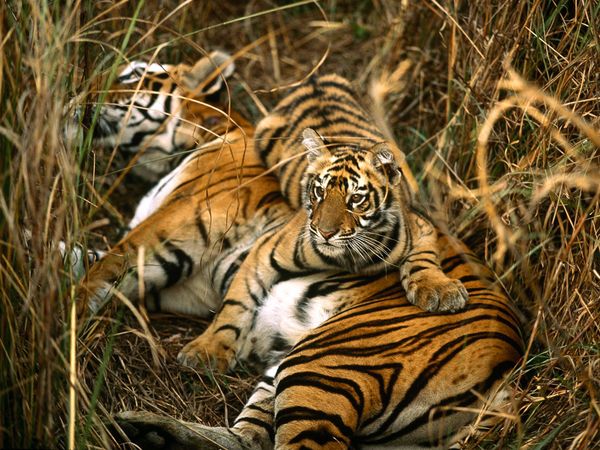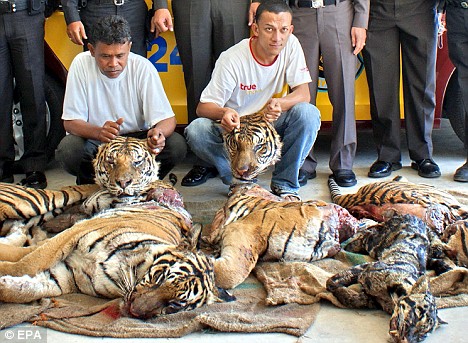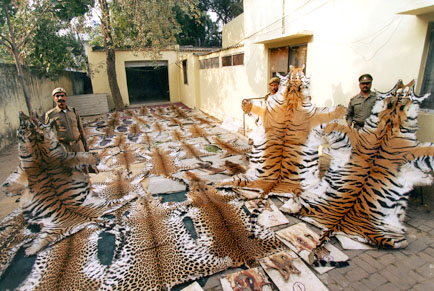
A mother Bengal tiger and her cub rest in the tall grass of a meadow. Tiger cubs remain with their mothers for two to three years before dispersing to find their own territory. Photography by Michael Nichols
The tiger, one of the most magnificent animals in the world, is also one of the most endangered. A cat of beauty, strength, and majesty, the tiger is master of all and subject to none — except humans. Of the eight original subspecies of tigers, three have become extinct within the last 60 years; and there are less than 50 South China tigers left on this planet — few, and possibly none, survive in the wild.
There are five different kinds or subspecies of tiger alive in the world today. These tigers are called Siberian, South China, Indochinese, Bengal, and Sumatran. Their Latin name is Panthera tigris. Tigers are an endangered species; only about 5,000 to 7,400 tigers are left in the wild. Three tiger subspecies, the Bali, Javan, and Caspian tigers have become extinct in the past 70 years.
Poachers are continuing to exterminate the world’s remaining Tigers. New demand across Southeast Asia for the skins, teeth and claws of tigers is endangering much of the great cats, particularly the Sumatran tiger. Currently, the demand for Tiger parts is centered in several parts of Asia where there is a strong market for traditional medicines made from items like tiger bone and body parts. Volumes are sizeable and there has been little enforcement action against poachers and traders.
What Needs to be Done to Save the Tiger:
– Local institutions and people Scientists who were closely involved in managing tigers at the local level, Hemendra Panwar of India and Hemanta Mishra of Nepal, pointed out an important lesson more than a decade ago: unless local community needs are met, conservation of the tiger will not succeed and protected areas will perish. Therefore, conservation programmes must reconcile the interests of people and tigers. In most situations, a sustainable tiger conservation strategy cannot be achieved without the full participation and collective action of individual rural households whose livelihoods depend on rights of access and use of the forests where tigers live.
– Technologies for conservation of resources There already exists a wide range of technologies and practices in forest and watershed management and agriculture, both traditional and new, for conservation of resources. The biological processes that regenerate forests and make agriculture less damaging to tiger habitats take time to become established
– Use of external institutions Institutions, such as NGOs, government departments, and banks, can facilitate processes by which local people develop their sense of ownership and commitment. When little effort is made to build local skills, interest, and capacity, people have no interest or stake in maintaining structures or practices once the incentives for conservation stop. Success hinges on people’s participation in planning, implementation, monitoring, and evaluation, which leads to the formation of new institutions or the strengthening of existing ones
– Conservation of tiger habitat and of prey In many areas peripheral to tiger habitat, grazing lands for livestock have been converted to crops or degraded by excessive use; livestock is of poor quality and of poor productivity; wood for fuel and building has been exhausted; and sources of income are limited. The rehabilitation of the natural resource base of local people is essential if they are not to seek their requirements in protected areas. This requires ecodevelopment with the support and cooperation of specialized government organs and the non-governmental conservation community.

The bodies and heads of the poached tigers in Thailand are displayed. Photo from www.dailymail.co.uk/


I hope they will not hunt anymore tiger